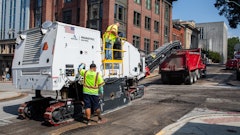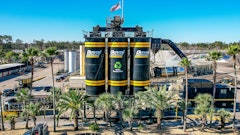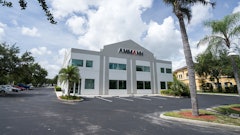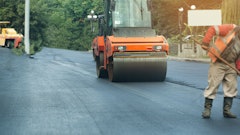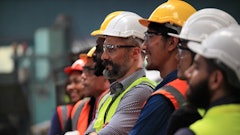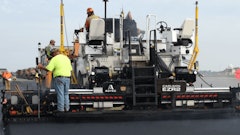A common misconception is that compact, commercial-class pavers (basically anything 16,000 pounds or less) are simply smaller versions of larger, mainline-class pavers. But aside from both being used to lay down hot, black asphalt, the two machine classes are completely different in design, capabilities, and quality expectations.
That's why so few manufacturers offer both commercial- and mainline-class pavers. It's also why the price of a commercial paver averages between $25,000 to $100,000, whereas mainline pavers range from $200,000 to $500,000. The game is basically the same, but the factors that make a good player are not.
Gravity or conveyor fed
Commercial pavers can be separated into gravity fed or conveyor fed — depending upon how they deliver asphalt from the hopper to the screed. Given a contractor's preferences and workload, each machine type has its advantages and disadvantages.
Gravity-fed units are the least expensive, typically priced between $25,000 and $50,000. Usually weighing less than 10,000 pounds, gravity-fed pavers offer 50 horsepower or less and provide maximum paving widths of 13 feet. As the name suggests, these pavers rely solely on gravity to feed asphalt from the hopper to the screed assembly. As asphalt is dumped into the hopper by feeder trucks, the paver's bed is hydraulically raised until gravity takes effect and draws the asphalt toward the screed, out of the paver, and onto the work surface.
Gravity-fed pavers aren't considered high-capacity or high-production machines. Though some contractors will pull 500 to 600 tons of material through them in a day, 200 tons-per-day is more common. So gravity-fed pavers are commonly used for driveway, small parking lot, and general road maintenance applications, but not for more demanding paving jobs.
Conveyor-fed commercial pavers, on the other hand, are often considered the Swiss army knife of compact paving equipment because they can handle such a wide variety of applications. Whereas the largest gravity-fed units offer maximum paving widths of 13 feet and engines generating up to 50 horsepower, these capabilities would depict the smallest equipment offerings of conveyor-fed pavers.
Conveyor-fed pavers rely on a system of conveyor belts that move the asphalt from the paver to the screed assembly. Because of this more consistent and controlled delivery, conveyor-fed units allow for much greater asphalt capacities. Even a smaller conveyor-fed paver can average 500 tons per day, while the largest 16,000-pound units often handle up to 1,000 tons per day. In fact, it's not unheard of for a contractor to push up to 2,000 tons per day of asphalt through a large, conveyor-fed paver. Therefore, conveyor units are typically considered production machines.
The increased capacities of these units also allow for a much higher quality finish. With any paving job, every time the paver stops, a bump is formed in the mat. This diminishes the overall quality of the application. Gravity-fed machines stop frequently because once the hopper is emptied, the paving train must stop so the bed can be lowered and the hopper refilled.
By relying on conveyors, not gravity, to deliver asphalt to the screed, conveyor-fed pavers can continuously receive new asphalt while pushing the feeder truck. And since hopper capacities are typically larger on conveyor-fed machines, even when the feeder truck empties, there is enough hopper capacity to continue paving while swapping a new, full truck into the operation. This allows for continuous paving and virtually seamless results.
The weight of a conveyor-fed commercial paver also helps it produce high quality results. Because they're heavier than gravity-fed machines, conveyor units can accommodate larger, heavier screed assemblies. Generally speaking, the heavier the screed, the more structurally sound it is and the better finish it produces.
Given the higher capacities and better quality results, conveyor-fed commercial pavers can be used for a broader range of applications. They can handle the work of gravity-fed pavers and also can take on larger parking lot, city street, county road, and secondary highway applications. Plus, they can be fitted with some of the same sophisticated automation that is usually found on larger, mainline pavers. Though they can't do the same quality of work, they can be very close. Of course this extra capacity, quality, and capability comes with a price. Depending on the unit and features, conveyor-fed commercial pavers will cost anywhere between $50,000 and $110,000.
The wide range of equipment designs and options available with either type of paver can complicate the selection process. Should a contractor choose a track- or wheel-driven paver? What screed options are available? Are there differences in durability? Are some units easier to transport? What about the controls? Though it can seem daunting, as long as a contractor fully understands what is available, what is expected from the paver, and how it will fit with the overall equipment fleet, many of these questions should answer themselves.
On the right track
One variable found with commercial-class pavers relates to how the equipment is propelled. Units are available that are either track- or wheel-driven. Quite frankly, today this is almost a moot point since roughly 95% of commercial pavers used in the U.S. are track-driven.
Even so, there are some advantages of wheel-driven units that have kept this option in the market. First of all, wheel-driven pavers offer higher travel speeds than track-driven units. This can be a major benefit when working on road maintenance applications, allowing operators to quickly travel from one pass to another, reducing the time traffic is impeded. Secondly, wheel-driven units travel on pneumatic tires that can safely roll over surrounding structures, such as curbs and sidewalks, without fracturing the concrete. This is a hazard presented by pavers with steel tracks.
So, with these obvious benefits, why do wheel-driven pavers make up such a small portion of the market? Traction, or a lack thereof, is the culprit. When working on unstable bases or subgrades, wheel-driven units have a tendency to spin their tires and get stuck. So wheel-driven pavers are a feasible option only for contractors who almost exclusively do maintenance or overlay work because they typically work on stable bases.
Though wheel-driven units are naturally kinder to surrounding concrete structures, options are available for track-driven units to make them more concrete friendly. One of the most common available options for commercial pavers are street pads, which are bolt-on rubber or urethane pads that mount directly to the steel tracks. With street pads in place, track-driven pavers can safely travel over curbs and sidewalks without fracturing the concrete. Street pads also offer the secondary benefit of increased tractive effort and smoother operation.
Finish up strong
Speaking of smoother operation, there are many screed options available to increase paving capabilities, speed up production, and provide better results. The screed is the last portion of the paver to come in contact with the fresh asphalt, forming and smoothing the material as it leaves the machine.
With most mainline pavers, the ability to produce a raised or tapered edge in the asphalt is integrated into the screed itself, but commercial pavers must offer bolt-on alternatives to achieve the same results. Bolt-on screed extensions give the operator more control over the material, while offering variable finishing configurations. Special plates that attach to the screed and narrow the paving widths are also available. This is ideal when paving bike or cart paths.
Another option found on many commercial-class pavers is screed automation. Screed automation enables the paver to adjust screed depth or material thickness automatically through the use of onboard computers. This is the same sophistication level found on mainline-class pavers and the goal is to provide better, more-consistent paving results by eliminating some of the human element on the job site. Several screed automation packages are available ranging from simple joint-matching packages that cost roughly $3,000, up to full-blown screed automation packages that can run up to $20,000.
When paving at full width, consistent material flow to the entire screed can be a problem. Some manufacturers counter this using screed-mounted material feeder augers.
On most pavers, mainline or commercial class, the material augers that displace asphalt to both sides of the screed are mounted in the hopper. As paving widths increase, these augers typically have difficulty shoving material efficiently to the widest expanses of the screed. This is why it is not uncommon to see laborers with shovels on either side of a paver helping direct asphalt to the entire length of the screed. Of course, this slows production, and considering the fact that these laborers are working 10-hour days shoveling 300° F materials, it is far from a pleasant activity.
So some machines now have material flow augers mounted directly to the screed. As the screed extends to handle wider paving widths, so too does the auger. Basically, this eliminates the need for laborers to redirect asphalt by completely automating the material flow process.
Tough enough?
From the moment a paver hits the job site it's receiving several tons of hot, abrasive aggregate. And this isn't a temporary occurrence. Pavers typically run from sunrise to sunset with few breaks in between. No matter how durable the paver, regular maintenance is unavoidable. But will it be something that needs to be maintained once a week or once a day? These maintenance intervals can make a big difference to the bottom line of a paving operation — and the materials that make up a paver's wear components can be key.
All manufacturers will list the materials that make up their respective augers and screed surfaces. Basically, the type of materials used will indicate the expected life of these wear components. Durability is usually indicated through a hardness rating. For instance, depending on the manufacturer, one might find the option of having wear components constructed of heavy-duty steel with hardness levels of 400 or more. A popular supplier of such materials is Hardox. Compared to standard-grade steel components, a 400 brinell or Hardox hardened steel will offer four to five times longer life. Of course, this added life comes with a price, but in the long run, contractors will typically find the extra price for more durable wear components will be offset by the amount saved through reduced maintenance requirements.
Have paver, will travel
Equipment and maintenance costs are one thing, but how will the choice of a paver affect the rest of a contractor's operation? As strange as it might sound, some contractors make their paver decisions based on portability. This applies mainly to smaller, entry-level contractors who typically work on smaller projects, but travel costs are an important consideration for any size operation.
Consider a contractor that chooses a larger, conveyor-fed commercial paver for his business. Because of its size, this paver will require a dedicated trailer and pickup to tow it to the job site. Another pickup and trailer will be needed to tow the supporting equipment. On the other hand, most gravity-fed pavers can fit on a trailer, along with a roller, skid steer, and all the needed hand tools. In this case, the contractor has cut the operation's travel expenses in half, towing all necessary equipment in one load.
It's important to remember that all equipment decisions should be tempered with an interest in productive capability. If the contractor who selected the small paver based on travel costs is confronted with the opportunity to do more substantial work, his equipment is now limiting growth. In an effort to save money on travel costs, a contractor can potentially lose work that would pay for the additional overhead of a second towing setup. If a contractor wants a machine that can handle a wide range of applications, from driveways to county roads, and will allow for growth, productive capability dictates that a larger, conveyor-fed paver is the right choice. But if a contractor is limited to smaller jobs and doesn't see this changing in the relatively near future, a larger conveyor-fed machine might add more expense than necessary.
Manual or automatic?
Be it a gravity-fed paver or a conveyor-fed paver, one of the biggest technology changes taking place today is the implementation of electronics. This is apparent with the available full-screed automation packages and also with operator controls.
Instead of presenting a series of levers that manually control paver operations, digital controls utilize a series of toggle and jog switches for automatic control. The benefits of this technology are numerous. Electronic controls are more precise and efficient, and they're easier to use for operators of any experience level. But there is a catch. Electronics don't mix well with a few elements — heat, liquid, and dirt — all of which are ever present on a paving jobsite.
For most smaller paving contractors, electronic controls are too foreign and threatening to merit consideration. These contractors are usually quite familiar with their equipment and like the fact that they know how to fix it. With manual controls, if something fails, contractors usually can repair it on the spot and continue paving. But if something electronic fails, it probably requires a certified technician to remedy the problem, which means dreaded downtime for the contractor. This fear alone steers many away from electronic control options, which is why most manufacturers offer both manual and electronic configuration options for each paver model.
But with greater risks come greater rewards. Electronics allow contractors to offer better, more easily repeatable results. Also, as the technology progresses, manufacturers are finding ways to better protect the electronic components, reducing reliability concerns. Yet, all equipment fails over time, and contractors will inevitably face issues with electronics. But as electronic controls become more efficient and reliable, more contractors will make the switch and electronically controlled machines will eventually become the industry standard.
Tim Hoover is sales and product manager, ProPaver by BOMAG Americas.
Learn Paving "Best Practices" at NPE
Contractors looking to learn state-of-the-art paving "best practices" can select from more than a dozen paving-focused sessions at the 20th Annual National Pavement Expo, Feb. 2-5 in Atlanta, including:
- Applying "Best Practices" to Your Paving Operation, John S. Ball III, Top-Quality Paving, Feb. 2.
- Make Big Profits Out of Little Jobs, Tom Skinner, Skinner Consulting Services, Feb. 2.
- Profitable "Best Practices" for Road Construction Success, Dale Starry, Ingersoll-Rand Co., Feb. 3.
- Effective Compaction of Hot Mix Asphalt, Jim Scherocman, consulting engineer, Feb. 4.
- Perfecting Asphalt Overlays, Alan Curtis, CHEC Consultants, Feb. 5.
For detailed descriptions and to register visit www.pavementonline.com.
F-525 Paver
- Tow-behind paver
- Independent, dual-controlled augers
- Paves up to 12 ft. wide & 2 in. deep
- Rubber-tired undercarriage
- 13½-in. hopper gate
- Optional screed heater and electric-hydraulic controls
1648 Power Box Paver
- Two fully extendable screed options
- Paving widths from 8 to 13 ft. and a paving depth to 6 in.
- Powered by a 41-hp Isuzu diesel
- Dual-speed hydrostatic drive system
- Compact 8-ft. 6-in. width
- Standard propane heating system
Gehl Company
Mauldin 550E Compact Paver
- Extendable augers for laying 6-in. mat to a full 13-ft. width, without the use of shovels
- Crawler or rubber tire models
- Gear-driven steering system
- 23-hp, 3-cyl. Kubota diesel
- Paving speed of up to 140 ft. per min.
Calder Brothers Corp.
8816 Asphalt Paver
- 5,000-lb., 130-hp track-mounted asphalt paver
- 8- to 15.5-ft. heat and vibrating screed system
- Dual operator stations
- 10-ton receiving hopper
- Independent sonic auger and conveyor system
LeeBoy
ProPaver 813RT
- Paving widths from 4 to 14 ft.; up to 16 ft. with optional 18-in. bolt-on extensions
- Paving depths from 0 to 6 in.
- 80-hp Isuzu diesel engine
- 7.5-ton hopper capacity
Bomag Americas Inc.
3020 Asphalt Paver
- 8-ton hopper and 21.5-in. hopper bed
- 73-hp Kubota diesel engine
- 8- to 13-ft. V-3 Xtend-a-Screed
- Vertical tow-point adjustment
- Independent washdown system standard
- Outboard track design
Ingersoll-Rand Co.











